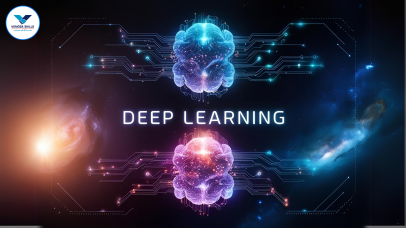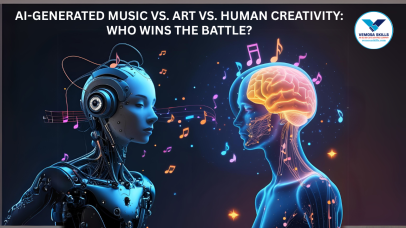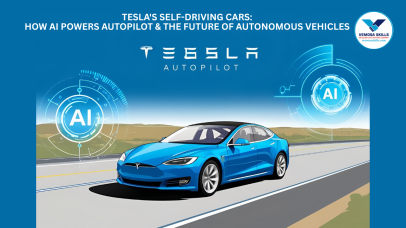Deep Learning: The Next Step in Machine Learning
Deep learning is a more advanced part of Machine Learning that uses special computer networks with many layers to process information. These networks work like the human brain and can learn from different types of data, such as pictures, sounds, and text. The word "deep" refers to the many layers in these networks, which help the system recognize complex patterns in the data.
The Structure of Neural Networks
A deep learning model typically consists of several layers:
Input Layers: Receives the raw data
Hidden Layers: Multiple layers that transform the input into increasingly abstract representations.
Output Layer: produces the final result, such as a classification or prediction
Each layer in a deep neural network takes out features from the data. For example, in image identification, the first layers might detect and recognize shapes, objects, or even entire scenes.
Real-Life Examples of Deep Learning
Autonomous Vehicles in Deep Learning: Self-driving cars rely heavily on deep learning to understand sensor data. Neural networks help these vehicles recognize road signs, pedestrians, and other obstacles in real time.
Facial Recognition using Deep Learning: Security systems use deep learning to analyze facial features, enabling everything from unlocking smartphones to identifying individuals in public spaces.
Voice Assistants using Deep Learning: Deep Learning models power speech identification systems that convert spoken language into text, enabling natural language processing for virtual assistants.
Why Deep Learning Is Important
Deep Learning has pushed the boundaries of what machines can do by enabling the analysis of unstructured data at scale. Its ability to learn complex patterns has led to big discoveries in areas such as medical imaging, self-driving, and natural language processing. However, deep learning models typically require large datasets and important computational power, which can be a limitation for some applications.
AI vs ML vs DL: Understanding Key Differences
While AI, ML, and DL are often mentioned together, it's important to understand their differences:
Scope and Breadth in AI, ML and DL
Artificial intelligence: The broadest concept, including any technique that enables machines to mimic human intelligence. AI includes rule-based systems, expert systems, ML, DL, and more.
Machine Learning: A subset of AI focused on learning from data. ML provides systems with the ability to improve their performance without clearly stated programming.
Deep Learning: A specialized form of ML that uses multi-layered neural networks. DL is best suited for handling unstructured data and complex pattern identification.
Application of Artificial Intelligence, ML, and DL
Artificial Intelligence: Includes a wide range of applications, from simple automation tools to complex reasoning systems.
Machine Learning: Found in recommendation systems, fraud detection, predictive analytics, and more.
Deep Learning: Dominates areas that require high-level pattern identification, such as image and speech recognition, natural language processing, and self-driving systems.
Computational Requirements in AI, ML, and DL
Machine Learning: Traditional ML models can often be trained on smaller datasets with modest computational resources.
Deep Learning: Typically requires large datasets and high-performance GPUs due to the complexity and size of the neural networks involved.
Flexibility and Adaptability in AI, ML, and DL
Artificial Intelligence: Includes both rule-based systems that are static and learning-based systems that evolve.
Machine Learning: Highly adaptable, as the models improve with more data and improved algorithms.
Deep Learning: Offers unparalleled accuracy in tasks like pattern identification but is less flexible in terms of ability to understand - understanding why a deep learning model made a particular decision can be challenging.
Why Understanding Differences Matters Between AI, Ml and DL
For Business and Industry Leaders:
Understanding the small differences between AI, ML and Dl can help companies make informed decisions when investing in technology. For instance, a business looking to implement a predictive analytics tool might choose traditional machine learning algorithms for efficiency, while a company working on advanced image identification might need to invest in deep learning capabilities.
For Developers and Data-Scienctists
For professionals in the tech industry, knowing which technology to apply in different scenarios is essential. Developers can design more efficient systems by leveraging the strengths of each approach - using ML for structured data analysis and DL for complex pattern identification tasks.
For Policy Makers and Educators
As these technologies increasingly impact society, policymakers and educators must understand their differences to craft effective regulations and study plans. This understanding helps in preparing the workforce for a future where these technologies are everywhere and in addressing ethical and privacy concerns.
For the General Public
An informed public is better equipped to understand the capabilities and limitations of emerging technologies. By grasping the differences between AI, ML and Dl, consumers can make educated decisions about technology use, privacy, and the effects of automation in their everyday lives.
Future Of AI: Artificial Intelligence (AI), Machine Learning (ML), and Deep Learning (DL)
The fields of AI, ML, and DL are evolving rapidly. As computational power increases and more data becomes available, these technologies will continue to advance. We can expect:
Greater Integration: Smooth and easy integration of AI systems into everyday life, from smart homes to personalized healthcare.
Improved Accuracy: Continued enhancements in deep learning algorithms will lead to even more precise applications in fields such as medical tests and self-driving.
Ethical and Regulatory Developments: As these technologies become more commmon, ongoing discussions about ethics, privacy, and regulations will shape how they are developed and deployed.
Understanding these differences today is not just an academic exercise - it's about preparing for the future. Whether you're a business leader, a tech enthusiast, or simply curious to grasp AI, ML, and DL, it will empower you to navigate and shape the world of tomorrow.
Conclusion
Artificial Intelligence, Machine Learning, and Deep Learning are more than just popular words; they represent a range of technologies that are transforming every aspect of our lives. While AI is the broad concept of machines imitating human intelligence, machine learning and deep learning are specialized tools that enable machines to learn from data and perform complex tasks.
By exploring real-life examples - from healthcare diagnostics to self-driving vehicles - and breaking down the technical aspects of each technology, we gain a clearer picture of how these innovations are shaping the future. As you move forward in this rapidly changing world, remember that understanding the differences between these technologies is important for using their full potential.
Accept this knowledge to make informed decisions - whether you're selecting the right technology for your business, investing in a career in tech, or simply engaging with the digital world around you. The future is here, and it's intelligent.





